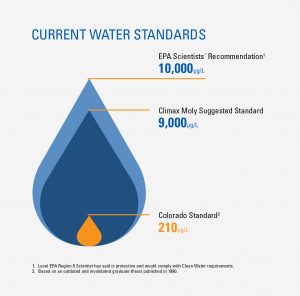Molybdenum, or moly, is a naturally occurring essential element found in everything from the food we eat to the vitamins we take, to our very own bodies. Molybdenum is also a critical component in everything from solar panels to transportation to national defense. Its unique properties allow us to make stainless steel that is recyclable, longer lasting, corrosion resistant, and stronger. If you have flown in a plane, driven across a bridge, or headed to work in a downtown skyscraper, moly has been a day-to-day part of your existence.
The Climax Molybdenum mines operating in Colorado are the largest producer of molybdenum in North America. Climax has a long-term history as a responsible partner and is dedicated to the health and safety of its employees and the communities they serve.
Climax has always been committed to maintaining water standards that are supported by science. The company invested in a world class, cutting edge $200 million plant to treat water before it enters Tenmile Creek. Climax consistently and voluntarily tests the waters of Tenmile Creek with certified laboratories and works closely with communities to ensure data is transparent and available.
You may have heard or seen debates about the levels of molybdenum in water. It is important to note that there have been no documented cases of molybdenum having a negative effect on humans in Colorado and that Colorado has been considering a water quality standard on molybdenum for more than 30 years. During that time, the state has adopted two human health-based water quality standards, both of which were based on obsolete science.
The first standard, adopted in 2007, was based on a 1960s-era Armenian study that has since been discredited by expert toxicologists. The current standard of 210 μg/l, adopted in 2010, is based on a 1990 graduate thesis that has significant shortcomings and its results have not been able to be replicated.
Since the mid-2000s, regulatory agencies in Europe and the United States needed verifiable, and credible studies to inform their regulation of molybdenum (and other chemicals). To address this need, The International Molybdenum Association (IMOA) sponsored human health-based studies conducted in accordance with internationally-accepted scientific protocols. These studies assessed the effects of molybdenum exposure through dietary, pre-natal, and multi-generational studies. All three studies were published and independently peer reviewed.
 This new research supports a standard of at least 9,000 μg/l, which is the standard proposed by Climax to protect human health. EPA’s Region 8 and its career scientists have stated in written comments that they would approve a standard as high as 10,000 μg/l. Recognizing that there is significant uncertainty about the current standard, including the 1990 graduate thesis that it is based on, the Colorado’s Water Quality Control Commission unanimously granted Climax an extension to 2020 to continue to operate under “current conditions.” Though there are always operational variations, the Climax mine operates well under the 9,000 μg/l standard.
This new research supports a standard of at least 9,000 μg/l, which is the standard proposed by Climax to protect human health. EPA’s Region 8 and its career scientists have stated in written comments that they would approve a standard as high as 10,000 μg/l. Recognizing that there is significant uncertainty about the current standard, including the 1990 graduate thesis that it is based on, the Colorado’s Water Quality Control Commission unanimously granted Climax an extension to 2020 to continue to operate under “current conditions.” Though there are always operational variations, the Climax mine operates well under the 9,000 μg/l standard.
As always, Climax Molybdenum is committed to relying on peer-reviewed, accredited research to support the health and safety of Colorado communities. This new science provides us with a scientifically sound standard that allows Climax to continue to act as an economic driver for rural regions of the state.
